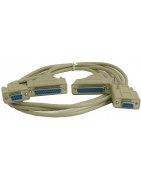Null modem adapter
1 x DB9 male and 1 x DB9 male connector
With screws for fixed mounting
39.00 kr
Varenummer NULLMODEM9M-M
What is a Null Modem?
A null modem is a serial cable that enables the connection of two Data Terminal Equipment (DTE) devices, such as computers, terminals, or printers, without using modems. This is achieved by crossing the transmit (TX) and receive (RX) lines in the cable, allowing direct data transfer between devices. In many cases, control signals like RTS (Request to Send) and CTS (Clear to Send) are also crossed to ensure proper communication.
Difference Between a Null Modem and a Modem
A standard modem cable connects a computer to a modem, which then establishes a connection with another device via a telephone line or network. In contrast, a null modem cable is used for a direct connection between two computers or other DTE devices without a modem in between.
Is a Null Modem the Same as a Gender Changer?
No. While a null modem adapter may look similar to a gender changer, they function differently. A gender changer only alters the connector’s gender (e.g., from male to female), whereas a null modem adapter reroutes the wiring so that transmit (TX) and receive (RX) are crossed, similar to a crossover cable.
What is a Null Modem Used For?
Null modem cables were historically used for file transfers between computers and remote system control. Although modern networks like Ethernet have largely replaced them, null modems are still used in specialized applications, including:
- Communication with industrial equipment
- Connecting to legacy hardware such as POS terminals or laboratory equipment
- Testing and troubleshooting serial connections
How to Identify a Null Modem Cable?
A null modem cable can be distinguished from a standard serial cable by examining the wiring connections:
- **Null modem cable:** TX (pin 2) is connected to RX (pin 3) and vice versa
- **Standard serial cable:** All pins are directly connected (1:1)
Limitations of Null Modem Cables
Maximum cable length: Typically up to 25 feet (approximately 7.6 meters), which is significantly shorter than Ethernet or fiber connections.
Limited speed: Null modem cables rely on serial communication protocols, making them slower than modern network connections.
Flow control: Basic null modem communication only works if flow control is not required. If data transmission exceeds the devices’ capacity, the connection may become unstable.
Is a Null Modem Adapter Necessary?
A null modem adapter may be required if two devices only have standard serial ports and need to be connected without a modem or network infrastructure. In many cases, this is a cheaper and simpler solution than upgrading to Ethernet or USB.
A null modem cable is used for a crossover serial connection (RS232) between two DTEs (computers, terminals, printers, etc.). The name originates from the use of RS232 cables to connect two teleprinter devices to two modems for communication.
The RS232 standard defines an asymmetric communication connection between two devices, where one is a DTE and the other is a DCE. With a null modem connection, the transmission and reception lines are crossed. Depending on the purpose, one or more handshake connections may also be crossed. Since a null modem connection is not covered by the RS232 standard, various wiring layouts exist.

Null modem adapter
1 x DB9 male and 1 x DB9 male connector
With screws for fixed mounting
Zero modem cable with DB9 male / female, 20 cm
Pin 2 to pin 3
Pin 3 to pin 2
Pin 5 to pin 5
Cable screen connected to DB9 male plug
Cable display is not connected to the DB9 female connector
The connectors are with finger screws
Zero modem cable with 2 x DB9 female, 28 AWG
Nullmodem kabel med 2 x DB9 hun, 28 AWG
Null modem cable 1 x DB9 male / 1 x DB9 female.
Sold in several lengths
Maximum versatility nullmodemkabel2 x she DB9 / 2 x DB25 female.
Sold in several lengths.
Universal null modem cable 2 x DB9 female / 2 x DB25 female.
Sold in several lengths.
Null modem adapter
1 x DB9 female and 1 x DB9 female connector
Operating Temperature -55 ° C to + 105 ° C
With Fixed Screws
The DB9 Null Modem Adapter converts a standard serial cable into a Null Modem cable
1 piece. DB25 male and 1pc. DB25 female Type 3
1 piece. DB25 male and 1pc. DB25 female Type 1
Null modem cable 1 x DB9 Han / 1 x DB9 She.
negotiated in several lengths
Universal null modem cable
2 x DB9 female / 2 x DB25 female
Length: 1.8 m
Zero modem cable with 2 x DB9 female, 28 AWG
Nullmodem cable with 2 x DB9 male, 28 AWG 2.0 m